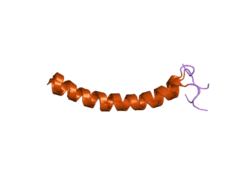LL-37
| LL-37 | ||
|---|---|---|

| ||
| 3D-Strukturmodell von LL-37 | ||
| Andere Namen |
| |
|
Vorhandene Strukturdaten: 2K6O | ||
| Eigenschaften des menschlichen Proteins | ||
| Masse/Länge Primärstruktur | 37 Aminosäuren | |
| Präkursor | (170 Aminosäuren) | |
| Bezeichner | ||
| Gen-Name | CAMP | |
| Externe IDs | ||
| Transporter-Klassifikation | ||
| TCDB | 1.C.33.1.10 | |
| Bezeichnung | Cathelicidin-Familie (Porine) | |
| Vorkommen | ||
| Übergeordnetes Taxon | Wirbeltiere[1] | |
| Orthologe | ||
| Mensch | Hausmaus | |
| Entrez | 820 | 12796 |
| Ensembl | ENSG00000164047 | ENSMUSG00000038357 |
| UniProt | P49913 | P51437 |
| Refseq (mRNA) | NM_004345 | NM_009921 |
| Refseq (Protein) | NP_004336 | NP_034051 |
| Genlocus | Chr 3: 48.22 – 48.23 Mb | Chr 9: 109.85 – 109.85 Mb |
| PubMed-Suche | 820 | 12796
|
LL-37 ist ein menschliches antimikrobielles Peptid aus der Gruppe der Cathelicidine. Es wird hauptsächlich in Immunzellen produziert und ist Teil der angeborenen Immunantwort sowie der Apoptose körpereigener Zellen. Es handelt sich um ein Transportprotein, dessen Einbau einerseits in die Zellwand grampositiver Bakterien sowie andererseits in die Zellmembran zu einem Verlust von Ionen und kleinen Molekülen führt. Es wird durch das CAMP-Gen codiert.[2]
Die Produktion von LL-37 wird insbesondere durch Stimulation des TLR-9, aber auch TLR-2 und TLR-4 und indirekt durch Vitamin D angeregt.[3][4]
Biosynthese
Die Biosynthese von LL-37 ist ein mehrstufiger Prozess. Es wird durch das CAMP-Gen auf Chromosom 3 codiert. Dieses Gen besteht, wie auch die Cathelicidin-Gene anderer Säugetiere, aus vier Exons. Die antimikrobielle Aktivität wird durch das hypervariable Exon 4 codiert, während die Exons 1 bis 3 eine Signalpeptidsequenz und die darauf folgende Cathelin-Domäne codieren.[5]
Primär wird ein Präpropeptide synthetisiert und in den Granula neutrophiler Granulozyten oder anderer Zellen gespeichert. Nach Freisetzung dieser biologisch inaktiven Propeptide werden sie enzymatisch durch Elastase oder andere Proteinasen in ein Cathelin und ein C-terminales antimikrobielles Peptid, das aus 37 Aminosäuren bestehende LL-37, gespalten.
Im Einbuchstabencode lautet die Peptidsequenz von LL-37 LLGDFFRKSKEKIGKEFKRIVQRIKDFLRNLVPRTES.[6]
Literatur
Zanetti M: The role of cathelicidins in the innate host defenses of mammals. (PDF) In: Curr Issues Mol Biol. 7, Nr. 2, Juli 2005, S. 179–96. PMID 16053249.
Einzelnachweise
- ↑ Suchergebnis Cathelicidine nach Taxonomie
- ↑ UniProt P49913
- ↑ Rivas-Santiago B, Hernandez-Pando R, Carranza C, et al.: Expression of cathelicidin LL-37 during Mycobacterium tuberculosis infection in human alveolar macrophages, monocytes, neutrophils, and epithelial cells. In: Infection and Immunity. 76, Nr. 3, März 2008, S. 935–41. Modul:Vorlage:Handle * library URIutil invalid. PMID 18160480. PMC 2258801 (freier Volltext).
- ↑ Yuk JM, Shin DM, Lee HM, et al.: Vitamin D3 induces autophagy in human monocytes/macrophages via cathelicidin. In: Cell Host Microbe. 6, Nr. 3, September 2009, S. 231–43. Modul:Vorlage:Handle * library URIutil invalid. PMID 19748465.
- ↑ Tomasinsig L, Zanetti M: The cathelicidins--structure, function and evolution. In: Curr. Protein Pept. Sci.. 6, Nr. 1, Februar 2005, S. 23–34. PMID 15638766.
- ↑ A. Pini, C. Falciani u. a.: A novel tetrabranched antimicrobial peptide that neutralizes bacterial lipopolysaccharide and prevents septic shock in vivo. In: FASEB journal. Band 24, Nummer 4, April 2010, S. 1015–1022, Skriptfehler: Das Modul gab einen nil-Wert zurück. Es wird angenommen, dass eine Tabelle zum Export zurückgegeben wird.. Modul:Vorlage:Handle * library URIutil invalid. PMID 19917670.